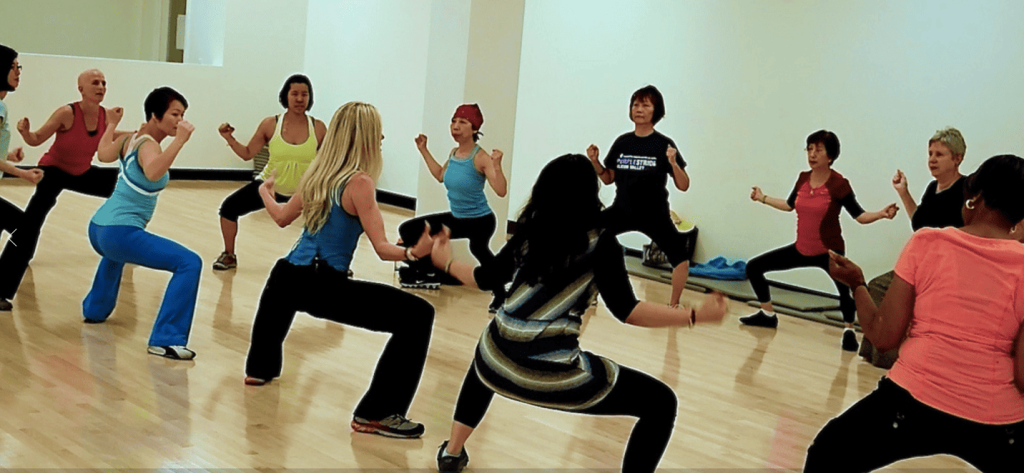HITLAB Team • January 23, 2024
According to 2018 National Health Interview Survey (NHIS), more than half (51.8%) of US adults had at least 1 of 10 selected diagnosed chronic conditions (arthritis, cancer, chronic obstructive pulmonary disease, coronary heart disease, current asthma, diabetes, hepatitis, hypertension, stroke, and weak or failing kidneys), and 27.2% of US adults had multiple chronic conditions.1 Chronic physical illness is psychologically draining to those experiencing it, and psychiatric disorders such as depression and anxiety are more common amongst such individuals, who are frequently required to adjust their lifestyle and aspirations to accommodate their physical ailment.2 To effectively address these health concerns, it is crucial that lifestyle-based interventions specifically target mental/psychological, physical, and social well-being. Promoting these three key dimensions of an individual’s overall health status becomes increasingly significant amidst the growing health challenges our society faces.3 Such interventions are likely to require a multimodal or multi-domain approach, encompassing a variety of beneficial lifestyle activities.4

In this context, studies in animal models have underscored the far-reaching benefits of environmental enrichment, which typically integrates multimodal stimulation of motor, sensory, cognitive, and social processes.5 Activities in humans that emulate this multimodal enrichment combine physical (body) and mental (mind) components to encourage an “embodied mind in motion”.6,7 An exemplary instance of such activities is found in dance or dance movement interventions (DMI), which seamlessly blend sensory experiences through music, physical movement, and mental stimulation in a socially engaging environment. DMI encompasses diverse programs, including traditional dance, aerobic dance, and dance/movement therapy—a form of creative arts therapy that incorporates psychological factors and techniques such as embodiment, creativity, emotional processing/reflection, and psychosocial integration, all of which are integral to mental health and overall well-being.8
Studies have shown DMI is effective in improving cardiovascular parameters in hypertensive patients9, quality of life outcomes in cancer patients,10 and cognitive function in elderly patients with metabolic syndrome.11 Hence, amidst the rising health challenges, innovative interventions like DMI, addressing physical, psychological, and social functioning, emerge as comprehensive tools with the potential to promote healthy aging, recovery, and disease management.12,13
Dance4Healing, an emerging social initiative, pairs individuals coping with chronic conditions, seniors, and caregivers with compatible companions to establish enjoyable and enduring routines through both recorded and live video classes. Grounded in neuroscience and clinical research, the program uniquely integrates behavior design and proprietary artificial intelligence (AI) to cater to diverse mobility levels and individual needs.

This approach aims to make creative arts therapy accessible to everyone, fostering a sense of connection and reducing feelings of isolation and loneliness. The product is driven by empathy, with a focus on nurturing positive behavioral changes. Guided by Fogg’s Behavior Model, which revolves around Motivation, Ability, and Prompt, Dance4Healing empathizes with users’ motivations, enhances their ability by providing round-the-clock access to pre-recorded dance videos derived from in-person classes, and employs effective prompts like buddy-matching and personalized interactions facilitated by their patent-pending AI.

In a recent assessment, HITLAB carried out a heuristic analysis of Dance4Healing’s web platform, concentrating on assessing the functionality and design of the user interface. The primary goal was to guarantee a seamless user experience and evaluate the platform’s suitability for real-world applications. Conducting usability studies plays a crucial role in identifying design issues within eHealth interventions, delving into user experiences, and proving valuable for assessing a system or program prior to an effectiveness trial. Usability assesses the ability of a system to be effectively, efficiently, and satisfactorily used in a specified context to achieve predetermined goals.14 This multidimensional concept encompasses factors such as learnability, memorability, efficiency, errors during system use, and overall user satisfaction.15, 16 The evaluation of usability is a pivotal aspect in determining the utility of a system or program, emphasizing its importance in gauging effectiveness and user satisfaction.16
This evaluation adhered to well-established usability standards16 and industry best practices, and HITLAB offered practical recommendations and suggestions aimed at refining and refining the platform. For instance, to enhance user guidance and support, it was suggested to integrate a Frequently Asked Questions (FAQ) and Help Section directly onto the home page. Also, considering the importance of visual appeal during dance sessions, the analysis emphasized the need to increase the size of the video display for a more immersive experience. Additionally, the platform was advised to diversify its dance content by incorporating more videos featuring various dance types and forms. This recommendation aimed to provide users with a broader range of experiences, enhancing overall engagement. Furthermore, some medium-priority suggestions included enabling users to select specific workout types such as Salsa, Zumba, etc. and optimizing the application’s functionality for users with more than one buddy.
In conclusion, the potential of dance movement therapy interventions, exemplified by initiatives like Dance4Healing, holds tremendous promise in reshaping the landscape of holistic healthcare. By seamlessly blending sensory experiences, physical movement, and mental stimulation in a socially engaging environment, these interventions address the multifaceted dimensions of health, targeting physical, psychological, and social well-being. Dance4Healing, as a distinguished social initiative, not only pairs individuals facing health challenges with compatible companions through innovative approaches but also leverages neuroscience, clinical research, and artificial intelligence to make creative arts therapy universally accessible. The transformative power of such interventions is further amplified through the collaborative efforts of organizations like HITLAB, which conducts heuristic analyses to refine digital health solutions. By focusing on usability standards, user experience, and real-world applicability, HITLAB contributes significantly to enhancing the adoption and adherence of products like Dance4Healing, ensuring that innovative health interventions become more effective, accessible, and impactful on the journey towards comprehensive well-being.
References:
- Boersma P, Black LI, Ward BW. Prevalence of Multiple Chronic Conditions Among US Adults, 2018. Prev Chronic Dis 2020;17:200130.
- News Medical: The Psychological Strain of Chronic Physical Illness
- World Health Organization . Promoting Mental Health: Concepts, Emerging Evidence, Practice: A report of the World Health Organization, Department of Mental Health and Substance Abuse in collaboration with the Victorian Health Promotion Foundation and the University of Melbourne. World Health Organization; Geneva, Switzerland: 2005.
- Rosenberg A., Mangialasche F., Ngandu T., Solomon A., Kivipelto M. Multidomain Interventions to Prevent Cognitive Impairment, Alzheimer’s Disease, and Dementia: From FINGER to World-Wide FINGERS. J. Prev. Alzheimers Dis. 2020;7:29–36. doi: 10.14283/jpad.2019.41
- Kempermann G. Environmental enrichment, new neurons and the neurobiology of individuality. Nat. Rev. Neurosci. 2019;20:235–245. doi: 10.1038/s41583-019-0120-x.
- Kempermann G. Embodied Prevention. Front. Psychol. 2022;13:841393. doi: 10.3389/fpsyg.2022.841393
- Podolski OS, Whitfield T, Schaaf L, Cornaro C, Köbe T, Koch S, Wirth M. The Impact of Dance Movement Interventions on Psychological Health in Older Adults without Dementia: A Systematic Review and Meta-Analysis. Brain Sci. 2023 Jun 22;13(7):981. doi: 10.3390/brainsci13070981. PMID: 37508913; PMCID: PMC10377702.
- de Witte M., Orkibi H., Zarate R., Karkou V., Sajnani N., Malhotra B., Ho R.T.H., Kaimal G., Baker F.A., Koch S.C. From Therapeutic Factors to Mechanisms of Change in the Creative Arts Therapies: A Scoping Review. Front. Psychol. 2021;12:678397. doi: 10.3389/fpsyg.2021.678397.
- Aweto HA, Owoeye OB, Akinbo SR, Onabajo AA. Effects of dance movement therapy on selected cardiovascular parameters and estimated maximum oxygen consumption in hypertensive patients. Nig Q J Hosp Med. 2012 Apr-Jun;22(2):125-9. PMID: 23175912.
- Raybin JL, Zhou W, Pan Z, Jankowski C. Quality of Life Outcomes With Creative Arts Therapy in Children With Cancer. Journal of Pediatric Hematology/Oncology Nursing. 2022;39(3):155-167. doi:10.1177/27527530211055988.
- Kim SH, Kim M, Ahn YB, Lim HK, Kang SG, Cho JH, Park SJ, Song SW. Effect of dance exercise on cognitive function in elderly patients with metabolic syndrome: a pilot study. J Sports Sci Med. 2011 Dec 1;10(4):671-8. PMID: 24149557; PMCID: PMC3761497.
- Herold F., Hamacher D., Schega L., Müller N.G. Thinking While Moving or Moving While Thinking—Concepts of Motor-Cognitive Training for Cognitive Performance Enhancement. Front. Aging Neurosci. 2018;10:228. doi: 10.3389/fnagi.2018.00228
- Basso J.C., Satyal M.K., Rugh R. Dance on the Brain: Enhancing Intra- and Inter-Brain Synchrony. Front. Hum. Neurosci. 2021;14:584312. doi: 10.3389/fnhum.2020.584312.
- ISO 9241-210: Ergonomics of Human–System Interaction – Human-centred Design for Interactive Systems International Organization for Standardization (2010), 10.1039/c0dt90114h.
- Fisk, A.D., Czaja, S.J., Rogers, W.A., Charness, N., Czaja, S.J., & Sharit, J. (2009). Designing for Older Adults: Principles and Creative Human Factors Approaches, Second Edition (2nd ed.). CRC Press.
- Nielsen, J. (2012). Usability 101: Introduction to usability.
Learn more about
Learn more about
Explore Recent Posts


